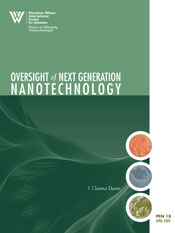Former EPA Official Calls For New Environmental & Consumer Protection Agency
Technological Advances Require New Oversight
 Washington, DC – Existing health and safety agencies are unable to cope with the risk assessment, standard setting and oversight challenges of advancing nanotechnology. The nation needs a new agency to address current forms of pollution and to deal with the health and environmental impacts of the technically complex products promised by rapid 21st century scientific advances.
Washington, DC – Existing health and safety agencies are unable to cope with the risk assessment, standard setting and oversight challenges of advancing nanotechnology. The nation needs a new agency to address current forms of pollution and to deal with the health and environmental impacts of the technically complex products promised by rapid 21st century scientific advances.
In a landmark paper, Oversight of Next Generation Nanotechnology, J. Clarence (Terry) Davies calls for a new Department of Environmental and Consumer Protection to oversee product regulation, pollution control and monitoring, and technology assessment.
According to Davies, “Federal regulatory agencies already suffer from under-funding and bureaucratic ossification, but they will require more than just increased budgets and minor rule changes to deal adequately with the potential adverse effects of new technologies. New thinking, new laws and new organizational forms are necessary. Many of these changes will take a decade or more to accomplish, but there is an urgent need given the rapid pace of technological change to start thinking about them now.”
In the 21st century governments face emerging technologies that enable common materials and chemicals to be manipulated in sophisticated ways at the nanoscale, which may pose unknown and not yet understood risks to human health and the environment. These novel materials improve performance of almost any product imaginable, from cosmetics to car batteries to cancer treatments, but little is know about the risks they may pose and there are many questions concerning their life-cycle impact.
“The idea for a new environmental and consumer protection agency may seem far-fetched to some, but before the creation of EPA in 1970 the idea of an organization dedicated to regulating pollutants harmful to human health and the environment also seemed far-fetched,” says David Rejeski, the director of the Project on Emerging Nanotechnologies. “Today, agencies like EPA and the Consumer Product Safety Commission lack the resources and tools needed to address the challenges posed by products enabled by advancing nanotechnology and synthetic biology.”
In the report’s preface, first EPA administrator William D. Ruckelshaus points out that the new Department of Environmental and Consumer Protection outlined in the paper “…would be more of a science agency than the current regulatory ones and would incorporate more integrated approaches to oversight and monitoring.” The proposed agency would foster more integrated oversight and a unified mechanism for product regulation to deal with current problems like toxics in children’s toys and newer challenges like nanotechnology. A more integrated approach to pollution control was necessary even before EPA was created, and since that time the need has only increased, according to Davies.
“Almost forty years ago, EPA greatly changed governance and regulation of the damage humans do to the environment,” Rejeski says. “But now, nearly a decade into the new century, the U.S. needs to take a bold step forward and address pollution and exposure in a more holistic and proactive manner. A new agency with a new vision and mission is needed to ensure technological innovation with minimal environmental impact.”
April 28, 2009
Summary
Existing health and safety agencies are unable to cope with the risk assessment, standard setting and oversight challenges of advancing nanotechnology. In a landmark report, Oversight of Next Generation Nanotechnology, J. Clarence Davies highlights the need for a new agency to address current forms of pollution and to deal with the health and environmental impacts of the technically complex products promised by rapid 21st century scientific advances.
Related
• Oversight of Next Generation Nanotechnology
